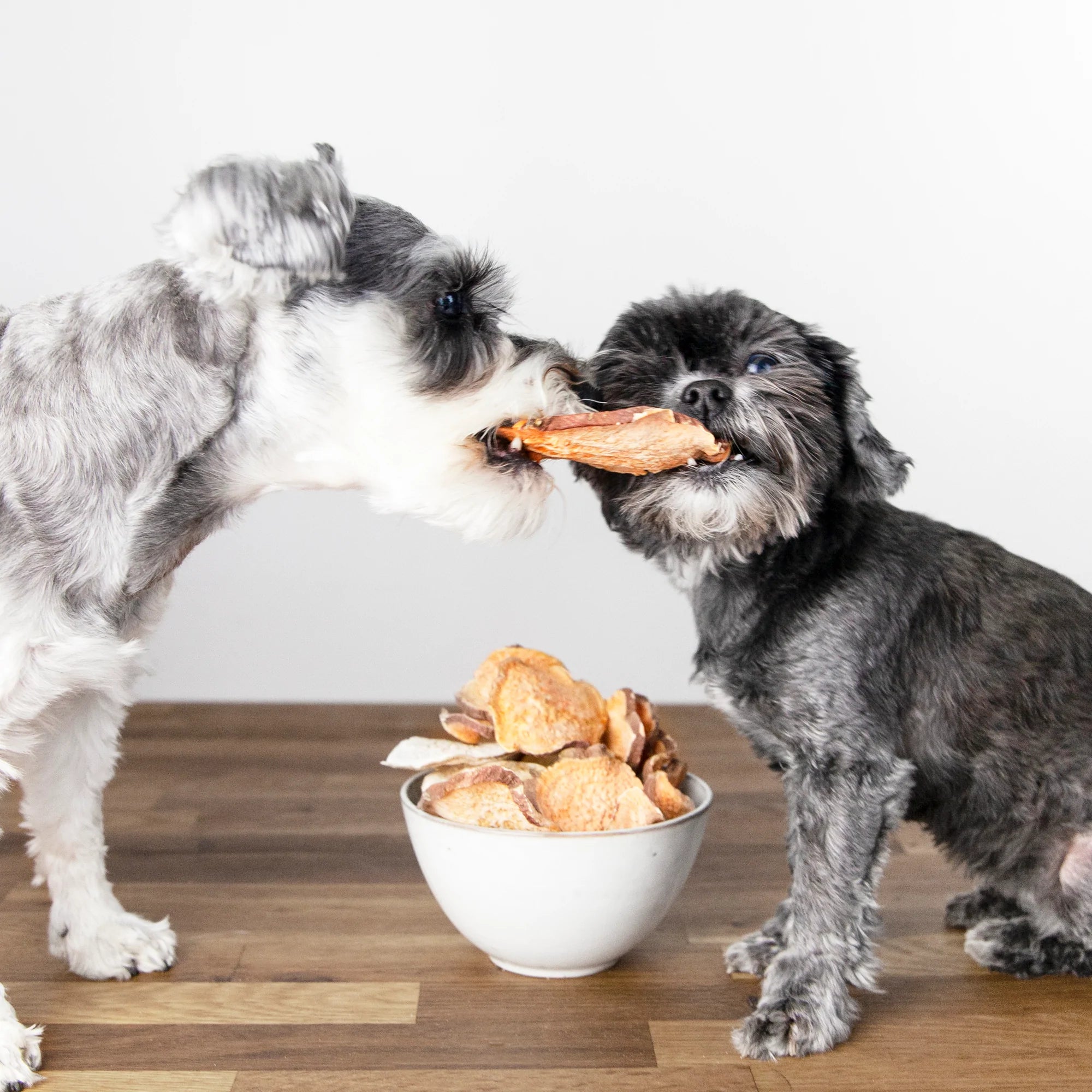How Many Treats Can You Feed Your Dog Each Day?

Giving your dog treats, from special training treats to their favorite kibble or people food, is one of the great joys of pet ownership. You get to watch your dog's tail wag, their excitement obvious in every line of their bodies. However, like people, many dogs must watch their daily calories in order to avoid obesity. Excessive dog treats can increase calorie count and lead to more health problems for your dog.
Just how many treats can you give your dog each day? There's no hard and fast limit that you have to consider. However, there are several things that you may want to take into consideration when deciding how many treats you want to hand out.
The 10% rule
In general, according to the American Kennel Club, your dog should not receive more than 10% of their diet in treats. By ensuring that your dog's diet consists primarily of pet food, with treats added in to account for no more than 10% of their daily calories, you can help keep your dog healthier. Keep in mind that the 10% rule applies to the number of calories your dog consumes, not to the volume of the food: some treats may be higher-calorie than others, which means that your dog would need to consume fewer of them in order to make up the same volume.
Is your dog having any weight problems?
If your dog has been struggling with weight gain, or if you start to notice significant weight gain, you may want to decrease the number of treats that your dog gets on a regular basis. If your dog's weight is too high, your vet may recommend lowering the number of treats they get, or looking for lower-calorie treats (green beans, for example, which are a surprising, healthy treat that your pup can enjoy) that will make your dog excited without adding substantially to their daily caloric intake.
What is your dog's daily activity level?
Your dog's overall activity level may have a significant impact on the number of calories your dog can safely consume each day. If your dog goes out for regular long walks, runs, or hikes with you, spends most of their time eagerly playing and running in the backyard, or is part of an active dog training program, your dog may be able to safely consume more calories than a dog who tends to lounge about on their favorite pet bed most of the day.
How big is your dog?
Large dogs naturally need more calories just to support their bodies. A large breed dog may be able to get away with munching on more chews and treats than a small dog. Furthermore, it will take more treats to make up the same percentage of your dog's diet when you have a large breed dog than a small one. You may want to look for treats specially geared toward your dog's size.
Does your dog have any special dietary needs?
If your dog has a special diet that they need to follow, it's important to take your dog's needs into consideration before selecting a dog treat—and to help determine how many of those treats your dog can have. For example, some dogs cannot tolerate human food. Others may cheerfully scarf down table scraps and enjoy the same food as the human members of your family on a regular basis. Pet parents generally have a good idea of their dog's needs and how to ensure that they get the right amount of treats, or the right type of treats, based on any specific dietary concerns.
Does your dog eat their regular food without complaint?
Pay careful attention to your dog's overall food intake. Some dogs may stop eating their regular food when they get treats too often, or may clearly show a preference for those treats over the food you usually give them. Picky eaters may benefit more from high-value treats that are designed to meet dogs' overall nutritional needs.
Why are you handing out the treats?
In some cases, you may want to carefully consider why you're offering those treats to your dog. For example, if your dog is in training, a healthy dog can receive more treats during their training sessions to help with compliance and learning. You may also choose to hand out treats for special occasions or good behavior. On the other hand, you should ensure that your dog does not receive too many treats on a regular basis—and if your dog does start struggling with weight, you may want to try using low-calorie treats to help with weight management.
Are you looking for luxury items for your furry family member? At Animals Matter, we help pet owners find luxury dog beds, bath supplies, car seats, and more. Contact us to learn more about how we can help keep your dog more comfortable.
FAQ
What happens if my dog eats too many treats?
Consuming too many treats can make it harder for your dog to maintain a healthy weight. Some dogs may also have stomach problems when consuming too many treats, especially if you give them human food as a treat.
How can I tell if my dog ate too many treats?
In some cases, your dog may show immediate signs of tummy issues due to eating too many treats. Your dog may vomit or have diarrhea. In other cases, your dog may seem slow and sluggish. Eating too many treats over a longer period of time may be a different matter. You may find that, when your dog maintains a diet with too many treats, your dog grows obese, seems less comfortable, and starts to have joint issues or not play as often.
Do dogs like the TV on when you're gone?
Dogs do not perceive the TV in the same way humans do. They may see more brief impressions of images, rather than the constant stream of images or story that humans might perceive. However, leaving the TV on when you're gone can help provide a source of stimulation for your dog, and may help alleviate loneliness.
Subscribe
Sign up to get the latest on sales, new releases and more…
Categories
- Tails of Celebration: Working Dogs of the Lares Trek, A Silent Partnership In Peru
- 5 Easy Organic Christmas Recipes for Dogs: Simple Holiday Treats Your Companion Will Love
- The 6 Best Luxury Gifts for Your Dog This Christmas: Thoughtful Holiday Comfort That Truly Lasts
- Why Playtime Matters: The Benefits of Mental Stimulation and Playtime with Your Companion
- Tails of Celebration: The Miao Dog-Carrying Festival - A Hero's Honor in China
- A Dog-Friendly Thanksgiving 2025: Comfort, Calm, and Easy Treat Recipes
- The Best Dog Beds for Winter 2025: 5 Luxury Styles for Warmth, Comfort & Orthopedic Support
- Tails of Celebration: The Feast of Saint Hubert — Belgium's Timeless Blessing
- Halloween Safety Tips for Dogs: How to Keep Your Companion Safe This Spooky season
- Tails of Celebration: Día de los Muertos / Day of the Dead for Pets, A Festival of Memory in Mexico
- How to Care for Senior Dogs in Fall: Mobility Tips & Joint Support
- Tails of Celebration: Kukur Tihar & The Tihar Festival of Nepal
- What is a VDI Testing for dogs ? : Insights, Procedures and Preventive Measures
- Cheap Dog Beds vs. Luxury Dog Beds: The Real Cost of a $50 "Disposable" Dog Bed
- Can Dogs Have OCD? Understanding Canine Compulsive Behaviors (CCD)
- Does My Dog Like Music? Find Out What Tunes Make Your Pup Wag!
- Effective Solutions for Food Aggression in Dogs
- 7 Frozen Treats Your Dog Will Love This Summer☀️🧊🍉
- The Best Waterproof Liners for Dog Beds: Protect Against Spills, Drool, and Accidents
- How to Cope with the Loss of a Dog: A Tribute to Every Companion We Carry in Our Hearts
- Top Tips on How to Prevent Matting in Dogs
- Understanding and Managing Dogs with Hip Dysplasia
- The Ultimate Guide to Dog Gut Health: Natural Remedies, Probiotic Insights and Signs of Poor Gut Health
- The Best Supplements for Dogs: Explore Top Picks for Canine Health and Wellness
- How Often Should I Brush My Dog's Teeth? Tips for Optimal Canine Dental Health
- Ultimate Guide on How to Comfort Your Dog During Fireworks this 4th of July
- Managing a Blowing Coat: Essential Grooming Tips for Double-Coated Dogs.
- 5 Daily Habits That Boost Your Dog’s Long-Term Wellness
- Mastering Crate Training a Dog: Tips and Benefits
- Dog Car Seats vs. Seat Covers: What’s The Best Option For Your Companion?
- Best Outdoor Dog Beds: Luxury, Durability, and Unmatched Comfort
- Is My Dog Overweight? Tips to Assess and Help Your Companion
- The Best Faux Fur Dog Beds for Ultimate Pet Comfort of 2025
- Dog Running Guide: How to Start, Train & Stay Safe when running with your Dog
- Indestructible Dog Beds? The Truth Behind the Term
- Top Tips for Effective Exercise for Dogs
- Effective Dog Ear Cleaning: A Step-by-Step Guide for Maintaining Healthy Ears
- How to Manage Dog Aggressive Behaviors: Expert Tips and Advice
- Effective Canine Ear Infection Remedies: Symptoms, Causes & Treatments
- How to Make a New Dog Comfortable in Their New Home - 2025 Guide
- Signs of Dog Allergy Symptoms and How to Help and Prevent Them
- Why Does My Dog Lick Their Paws? Causes and Solutions Explained
- Dog Alzheimer's: Symptoms, Causes, and Treatment Options
- The Legacy of Comfort with the Iconic Animals Matter® Ortho Companion-Pedic® Puff Luxury Dog Bed
- Orthopedic Square Dog Beds: The Ultimate Blend of Luxury, Comfort, and Support
- Loungers: The Ultimate Beds for Luxury, Comfort, and Orthopedic Support
- Square Dog Beds: Orthopedic Comfort and Stylish Designs for Your Companion
- Effective Solutions for Canine Incontinence: Identifying Causes and Best Treatments
- Ethical, Sustainable, and Certified: Why Certified Products Matter, Exploring CA Prop 65 and CertiPUR-US® Standards
- Dog Seizures: Signs, Causes, and How to Help Dogs with Seizures


Leave a comment
Please note, comments must be approved before they are published